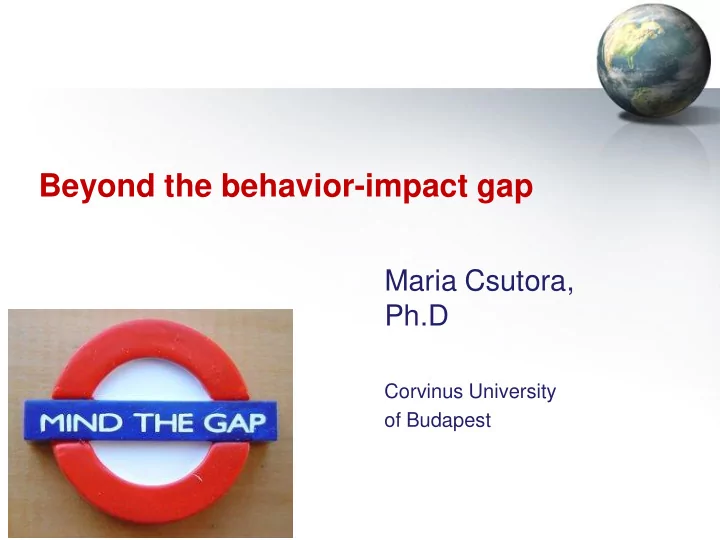

Beyond the behavior-impact gap Maria Csutora, Ph.D Corvinus University of Budapest
Background of the study Research question: “H ow much of a reduction in ecological • footprint can be achieved through voluntary action ” Csutora, M.: One More Awareness Gap? The Behaviour – Impact Gap Problem, • Journal of Consumer Policy, Vol. 35, No. 1. (1 March 2012), pp. 145-163, or through • Follow-up: New York Times online h ttp://www.nytimes.com/roomfordebate/2012/07/30/responsible- shoppers-but-bad-citizens/individual-actions-just-dont-add-up-to- environmental-change
Presentation outline 1 2 3 Good policy Description of Definition and examples the survey reasons for the behavior-impact gap
Awareness gaps • Studies suggest that there exists a gap between environmental awareness compontents (Zsóka, 2009) Consumers with high level of environmental awareness may not act sustainably. (Sanne, 2003), (Gatersleben et al. 2002; Thøgersen and Grønhøj 2010), Kollmuss and Agyeman (2002), Thøgersen, JCP 2005) • According to Sanne (2002) consumers are locked into unsustainable lifestyles (e.g. by social norms), even though they are not necessarily willing and happy to act this way. • But sometimes, even with these barriers, people do act on their environmental awareness and we generally assume that doing so will lead to reduced ecological impact. So this gets to the heart of my research.
The BIG question … • Does action by green consumers have a beneficial environmental impact as compared to actions by brown consumers? How much is this impact?
The BIG question … • Is there a big impact? We can rely on awareness raising policy campaigns.
The BIG question … • Is there a small impact? Change in the policy is needed. Then, It will require systemic change in regulations, etc. and production and infrastructure changes
Hypothesis of the study Ecological footprint of consumption Uninterested consumers Impact of environmental behaviour “Green” consumers have lower footprint than uninterested „green” consumers of consumers similar income Income
Survey 1012 respondents, representative survey of Hungarian residents • Adult population • • Lead by Corvinus University of Budapest • Used one of the most acknowledged opinion poll institutions • Questions: For ecological footprint components – – Pro-environmental behavior – Life satisfaction – Demographic questions PRO-ENVIRONMENTAL BEHAVIOUR ECOLOGICAL FOOTPRINT (EUROBAROMETER QUESTIONS):
Definition of “green” and “brown” consumers PRO-ENVIRONMENTAL BEHAVIOUR zero activity: brown (EUROBAROMETER QUESTIONS): 21.5% Chose an environmentally friendly way of traveling Reduced consumption of disposable items 1-3 acitivities: average Separated most of their waste for recycling 56.9% Cut down on water consumption Cut down on energy consumption Bought environmentally friendly products 4 or more activities: marked with an environmental label green Chose locally produced products or 21.6% groceries Used car less
Measuring ecological footprint Detailed questions on major items (based on previous studies) Diet • Energy bill (electricity, heating) • • Detailed questions on mobility Spending structure in case of minor items Footprint was calculated usig EF • values from the Global Footprint Network national accounts Consistency with national • consumption was checked
Survey finding No significant difference was found between the ecological footprint of green and brown consumers
Behavior-impact gap • A BIG problem is confronted whenever the required Observed level The level of ecological impacts behavioural change is of impacts achieved, but the observed ecological effect is minor or Behaviour- Impact-Gap Interfering missing behaviour Contextual Expected level factors of impacts The observed level of pro-environmental behaviour
Reasons for the behavior impact gap. Offset by increased use of high footprint items (Imported • exotic organic food may not be better environmental choice than non-organic local food). • Contextual factors beyond the competence and influence of consumers (market demand and supply, infrastructure) • Misleading market segmentation (eco-labeled products)
Reasons for the behavior impact gap. Chose easy-to-do but marginal actions in the target field • • Interfering behavior (Over-enthusiasm in separating waste, accompanied by rare enthusiasm in buying articles made from recycled material) Rebound effect •
CONCLUSIONS Pro-environmental behaviour was coupled with only • a small reduction in ecological footprint in specific areas. • More emphasis should be placed on communicating the ecological consequences of consumption habits. • Re-structuring of the socio-economic determinants of life, including the culture of consumption, is necessary. There is still a place for individual action. One can be a • green dot below the regression line, even though most people would not do the same
Beyond the behavior-impact gap Focus on “big impacts” Communicate Monitor frankly about impacts, not the sacrifice just behavior Making an needed impact Prevent Regulation and rebound effect infrastructure are (pricing) essential
Biggest impacts Food: Too much food, too much meat, wasting) 42%of footprint in my study Mobility: 14% Energy: Heating and cooling, electricity: 18%
Good examples: regulation with big impact • EU building codes – Energy Performance of Buildings Directive (EPBD) requires Member States to ensure that by 2021 all new buildings are so- called 'nearly zero-energy buildings (passive houses) – Phasing out incandescent bulbs
Healthy diet supports the environment – double dividend in diet amendments Too much Obesity Carbon food or Health emission too much problems meat
Stop wasting Formally fruits and vegetables that looked different were not allowed to • be marketed. “Straight cucumber" standards seem ridiculous during crises time. • "Cucumber Regulation" (EEC No 1677/88) and the "Carrot Regulation" (EEC No 730/1999) set EU-wide quality standards 2009. phasing out of minimum • EU standards for 26 types of fruit and veg http://www.europarl.europa.eu/sides/getDoc.do?pubRef =-//EP//TEXT+IM- PRESS+20090706STO57744+0+DOC+XML+V0//EN
Reducing consumption is essential Energy: reinventing physical work, e.g. • “Garden fitness” as an alternative to jogging Stop freezing in the summer and • sweating in the winter • Increasing longevity of goods, slow fashion, slow tourism Long term planning is • essential for mobility
• I gratefully acknowledge the TÁMOP-4.2.1/B- 09/1/KMR-2010-0005 project for financing this research and the Norwegian Financial Mechanism and the HU0056 project for making their survey data available for this study.
Recommend
More recommend